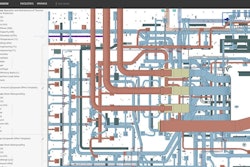
In a development of special interest to concrete contractors, additional venture funding for Tel Aviv-based SiteAware’s photogrammetry, artificial intelligence (AI) and drone solution for construction verification indicates additional potential for broad market adoption. The solution has already made inroads with major U.S. contractors including Hines, Trammell Crow Company, Whiting-Turner and Ryan Companies.
A $15 million series B round of venture financing announced by the company today may in large part be attributable to these contractors moving the technology out of the proof-of-concept phase and into broader application across their operations.
The round led by Vertex Ventures Israel, along with participation from existing investors Robert Bosch Venture Capital GmbH, Axon Ventures, Oryzn Capital, The Flying Object, and lool Ventures. The technology is broadly applicable to vertical construction and particularly on projects that involve concrete.
SiteAware’s platform turns elements of project plans into tagged data that comprise a digital twin of a structure. Stages of construction are documented with drone, on-site cameras and manual photogrammetry. Once uploaded to SiteAware, the application compares the images to the digital twin to capture as-built documentation and ensure it is completed to plan, leveraging AI to identify construction errors in real time.
Targeting the rework budget
In a telephone interview with ForConstructionPros, SiteAware CEO Zeev Braude said the company’s value proposition hinges on the ability to identify errors before concrete is poured, saving extensive budget for rework.
“Imagine all your projects ahead of schedule and zero dollars allocated for rework from your contingency budget,” Braude said. “That is what we can offer them in the areas we are very strong. For the first time, construction contractors can identify in real time the difference between the intent, the plans and the field work and address those gaps in real time so there is no rework. Rework is one of the biggest challenges in the industry. It creates unpredictable outcomes on a project—on the budget, the schedule or the final product.”
Braude said the product can be viable even on smaller stick-built projects, but comes into its own on concrete-intensive vertical construction.
“If a contractor is doing concrete work, this is an immediate opportunity, Braude said. “Another thing that makes SiteAware a good fit is If you have a lot of systems in the walls, like hospitals where you have systems that go in the walls. And then those systems go from one level to the next. When you are pouring concrete and make mistakes and then pour concrete, those systems are at risk and you have to do a lot of rework. Another factor is exposure to budgetary risk and schedule risk, and that is more than 95 percent of the market.”
The application is also used by contractors to support the application for payment process, according to Braude, eliminating ambiguity and emotion when making the appeal to a project owner that they should be paid for a body of work on a project.
“SiteAware’s DCV (digital construction verification) is a game changer for the construction industry,” Vertex General Partner Emanuel said. “As the first mover in this new category, SiteAware is blazing a trail for the entire construction industry to follow, ultimately allowing the sector to leverage technologies that will make it more efficient, transparent and smarter. We look forward to working closely with the team at SiteAware as it expands its footprint and deepens its work with industry leaders around the world.”
From beta into wide usage
While a number of major contractors were early adopters, the new round of funding coincides with the expansion of the SiteAware footprint within these contracting organizations.
“What we have seen in the past two years is that general contractors have started using our tech on one, two or three projects,” Braude said. “Now, they are standardizing all their new projects on our technology. So now they have a consistent, predictable risk mitigation technology that helps them work without rework on the job site.
“This broader roll-out brings some change management requirements.
“The challenge is our technology needs to be part of the production process,” Braude said. “It took the product time to mature. It took our customers time to see that it is part of their production process, but it does not change the way they are working. It just helps them as a support system to make them a better builder. “As the technology is used more broadly, it has gone down market from the major projects where it was originally deployed during beta phases of adoption. “We started at the high-end buildings that were very challenging from a cost perspective and there we have made a big impact,” Braude said. “Now we are on stick-built projects on the bottom of the construction pyramid. This technology is valid and will be available to any construction type.”
Deep tech stack
The SiteAware application is completely cloud-based on AWS Cloud Services in North America, with redundancy across geographic nodes. At present it needs no edge computing components, which may become necessary if it is used in areas with no or compromised connectivity.
“We are running ahead of our competition because of our tech stack,” Braude said. “Our digital twin is unique from the fact that it is tuned for air verification. A lot of digital twin companies are doing job site documentation with a camera on a hard hat or someone walking around with a camera, and then developing a digital twin for monitoring of work. Ours is focused on finding the gaps between the plans and the field work. We are providing technology that is very unique in terms of the impact on the industry. For the first time general contractors can verify the plan and that work conforms to the plan.”
The overall tech stack consists of a digital twin made up of a digital plan and photogrammetry, enabled by artificial intelligence that can identify images of construction elements in the field and compare them to the plan. This data is available to general contractors, trades and other stakeholders in a browser-based platform.
“The fact that contractors have access to this verification information in real time means they can address observations, close them out as corrected in the field, accepted as installed and there are coordination pieces we are defining,” Braude said.
 SiteAware captures photogrammetry images on the construction site and uses AI to identify variances from the plan, enabling construction managers to rectify, accept the variance as-is or take other action.SiteAware
SiteAware captures photogrammetry images on the construction site and uses AI to identify variances from the plan, enabling construction managers to rectify, accept the variance as-is or take other action.SiteAware
Venture funds for go-to-market
SiteAware currently has a small internal sales team focused on Texas, Florida and the Mid-Atlantic. Braude said the company plans to leverage the latest round of venture funding to build out a distribution channel across North America, putting its digital twin verification technology in the hands of more contractors. “I would like to find resellers to our technology,” Braude said. “I think we can complement many other service providers to the construction industry. We look forward to working with other providers who focus on risk mitigation like insurance providers who are interested in what we are doing.”
SiteAware’s growth plans also present opportunities for value-added resellers (VARs). “They (VARs) need to have access to general contractors,” Braude said. “They need to come from the construction industry, so they understand the value add. I think we would welcome both regional and national partners, and I am sure time will tell what is better. But I do see an opportunity for regional partners.”
BOTTOM LINE: Disruptive technologies like AI, photogrammetry and drones are coming to the construction market in fits and starts. But with solid uptake among major contractors, SiteAware is in an excellent position to bring its tech to a broad market. The availability of funds and the intention to use them to drive go-to-market efforts suggest more contractors will have access to bring this tech to even modest projects across the United States.


















